
Check out photos from Miss Apone Lao beauty contest in Vientiane capital, Laos
at http://samakomlao.blogspot.com
Photos from Miss Apone Lao beauty contest in Vientiane
Champasak province, located in the southern most of Laos, is a new paradise for tourists who want to experience Lao culture, beautiful nature, and adventure.
Check out the video above for more details.
Champasak, paradise in southern Laos promotion video

More than 100 elephants are expected to take part in Laos ' third elephant festival to be held next year, according to organisers ElefantAsia.
The festival will take place on February 14 and 15 next year in Xayaboury town, Xayaboury province.
ElefantAsia Communications Officer, Ms Ingrid Suter, said the organisers loved elephants so much that Valentine's Day seemed like the perfect time to schedule the event.
“The festival will be a celebration of cultural and traditional ties between the local community and elephants, as well as drawing local and international attention to the endangered status of this charismatic species,” Ms Suter said.
“Xayaboury province is a great location because it is very picturesque with beautiful rivers and mountains.”
The festival will feature an elephant procession, mahout demonstrations, elephant bathing, an outdoor elephant museum, a traditional baci ceremony, fruit and flower offerings, monk blessings, live performances from local and foreign artists, and night markets.
A documentary film about elephants will be shown on a large outdoor screen and people will also be able to go for elephant rides in the neighbouring forest.
Organisers will award a motorbike to the mahout whose elephant is the healthiest and best-looking at the festival. The owner of every elephant that takes part in the festival will also receive a first-aid kit to use in the care of their elephant.
Visitors to the festival can choose from a range of accommodation options, including hotels, guesthouses or camping.
“The 2008 festival was held in Paklay district of Xayaboury province and local people made a good income from offering reasonably-priced home-stay for visitors,” Ms Sutor said.
“People in Xayaboury town expect to do the same next year.”
Visitors can fly direct from Vientiane to Xayaboury in about 50 minutes. Travelling via hire car or local bus from Luang Prabang to Xayaboury province takes two to three hours or 10-12 hours from Vientiane .
ElefantAsia is a non-profit organisation which has been operating in Laos since 2001 and aims to protect the Asian elephant.
Ms Suter said there were about 1000 wild and 600 domesticated elephants in Laos .
The 2008 festival featured 70 elephants and attracted more than 50,000 people.
By Phonesavanh Sangsomboun
Vientianetimes
100 elephants expected to stomp to festival in Laos
Better known for its war than its tourist sights, Vietnam is rapidly emerging as one of Asia's most exciting new destinations, with a 'tiger economy' to boot. A peaceful, exotic and friendly country with a long, fascinating history, it's certainly one of the hidden gems in Asia.

What’s Cool
Ancient Hanoi, incredible scenery of Halong Bay and the North, trekking from Sapa hill station, charming Hoi An, friendly locals. Try fresh seafood, local beer and rice wine, sample intriguing history, culture and traditional shows, buy antiques, visit tribal villages near Dalat and Sapa, bask on endless beaches, or take boat trips in Mekong River. The enduring impression of Vietnamese ladies riding bicycles in ao dais (traditional dresses) with conical reed hats is unforgettable.What’s Not
The heat, mad traffic in big cities and the unbearable din of scooter hooters, unreliable bus services, cyclos hustlers, aggressive sellers, nagging beggars, spicy food that causes diarrhea, occasional bird flu!Essential Info
Time: GMT+7Electricity: 220V 50Hz 3-Pin Plug
Money: Baht: 1US$ = 32 Baht
Phone: ICC (+66) Outgoing: 001
Vietnam boasts intriguing hilly scenery, lush green jungles, pristine beaches and the beautiful waters of the Mekong Delta. An array of beautiful architectural wonders with French, Chinese and Vietnamese characteristics offer an enchanting experience alongside the vibrancy of increasingly cosmopolitan cities.
Hanoi is the northerly situated capital, often overshadowed by the country's previous capital and most modern city, Ho Chi Minh City. It offer lakes, temples and even dog meat but largely lacks the quality museums and shopping of its southern rival. Hanoi does make a great launching base for trips to Ha Long Bay, however - a UNESCO protected geological wonder.Travel along the lengthy coast to experience the royal city of Hue, the protected treasure that is Hoi An and Vietnam's ultimate beach resort, Nha Trang, or cool off inland at hill stations such as Dalat in the Central Highlands. Wherever you go, mind your step: Vietnam has almost two times more motorbikes than any other ASEAN nation.
Travel to Vietnam - Getting There
Vietnam has international airports in Hanoi, Ho Chi Minh City and Danang. Vietnam Airlines provides international flights from Bangkok, Kuala Lumpur, Manila, Phnom Penh, Siem Riep, Singapore, Osaka and many countries in Europe, with cheap internal flights available at short notice. Buses from Cambodia are also available but the journey is long and can be unreliable. Travellers may also get on a cargo ship to Ho Chi Minh City, Danang and Haiphong from Thailand, Hong Kong, Japan, Singapore or France while trains travel between Vietnam and its neighboring countries. To get around in Vietnam, mini buses and local buses get you there if you're patient, cars cannot be rented without a driver. You'll never have difficulty flagging down taxis, cyclos and motorcycle taxis.Vietnam Things to Do
- Ho Chi Minh City (Saigon)
- A hub of entertainment and industry with a variety of trendy places and charming sidewalks lined with French colonial architecture.
- Hanoi
- The vibrant 1000 year old capital city boasts an array of natural wonders and exquisite, timeless landmarks, including several misty lakes soaked in legend. Day trips to the remarkable local natural landscapes are a must.
- Dalat
- A quaint, arty hill station town with plenty of relaxing romantic character.
- Hoi An
- rent a bike and tour this charming, peaceful riverside town with ancient temples and an eclectic mix of foreign influence. Nearby is the two thousand year old Champa ruins of My Son.
- Halong Bay
- Known as one of the most breathtaking sights in the country, Halong Bay boasts limestone formations, coves and gorgeous cliffs making it one of the world's most remarkable seascapes.
- Beaches
- Relax on one of many pristine beaches in the south including China Beach, located between Danang and Hoi An, the quiet My Khe Beach, the popular beach in Nha Trang, Mui Ne Beach, Hon Chong Beach and Bai Tam.
Vietnam Travel Guide

A cave explorer stands before an imposing stalagmite made of mineral deposits near an entrance to the Xe Bang Fai River cave in central Laos.
An expedition in February 2008, co-led by veteran caver John Pollack, comprehensively mapped and photographed the 5.9-mile (9.5-kilometer) length of the little-known cavern for the first time.
The spelunking team encountered some of the largest rooms and most impressive structures of any river cave on Earth, Pollack said.
A river cave is any cave with an active water source flowing through it.
Everything about the cave is big from its towering entrances to its phobia-inducing spiders, which can be 10 inches (25 centimeters) across, Pollack added.
"It's also extremely well decorated with spectacular formations," Pollack said.
MORE PHOTOS:.
Scot Hoffman
—Photograph by Dave Bunnell
Travellers discovered gigantic river cave in Laos !
 With exotic culture, fantastic natural scenery and beaches, excellent cuisine and the famous 'Thai smile', Thailand attracts over 10 million visitors a year. Voted as the world's best value destination in a recent poll, it boasts lovely coastal areas, cosmopolitan cities, unspoiled countryside, great shopping and plenty of activities.
With exotic culture, fantastic natural scenery and beaches, excellent cuisine and the famous 'Thai smile', Thailand attracts over 10 million visitors a year. Voted as the world's best value destination in a recent poll, it boasts lovely coastal areas, cosmopolitan cities, unspoiled countryside, great shopping and plenty of activities.What’s Cool
Nightlife and shopping in Bangkok, stunning beaches of Phuket and Krabi, history and culture, trekking in the Northern jungle, scuba diving in the Andaman Sea, climbing in Krabi, lots of cheap Thai food, great hotels, friendly people and comfy tourist infrastructure.What’s Not
Bangkok traffic, overly spicy food, hustling tuk-tuk drivers and bar girls, crowded Patong (Phuket), noisy neighbourhoods, the hot season, reckless driving, riptides, corrupt officials and the occasional coup!Visas
US/Can: on-arrival (30 / 15 days)EU: on-arrival (30 / 15 days)
Aus/NZ: on-arrival (30 / 15 days)
Essential Info
Time: GMT+7Electricity: 220V 50Hz
Round 2-Pin Plug
Money: Baht: 1US$ = 34 Baht
Phone: ICC (+66) Outgoing: 001
The 'Big Mango', Bangkok, is a concrete jungle that packs megamalls and cutting-edge nightclubs in among its notorious traffic jams. Bangkok has gleaming temples and palaces and some of the best shopping and nightlife in Asia. The Grand Palace here will take your breath away, as will the ancient ruins upriver at Ayutthaya.
The islands and beaches of southern and eastern Thailand have many popular destinations and most visitors head straight for the beaches of Phuket, Samui or Krabi, yet up-and-coming hotspots like Phi-Phi, Koh Chang and Koh Lanta are new firm favourites. If you don't just want to see what's on land in this nation of spicy papaya salad, you may like to explore the underwater offerings of the remote Similan or Surin islands.Central Thailand is the historical heartland of Thailand with grand historical ruins such as Ayutthaya and Sukhothai, while Northern Thailand is covered with rugged, jungle-clad mountains that are dotted with hill tribe villages which make for spectacular trekking around Chiang Mai, Chiang Rai and Mae Hong Son. The northern city of Chiang Mai offers trekking adventures into hill tribe dotted territory as well as plenty of modern conveniences and is a great launching pad for discovering the smaller tourist spots of Mae Hong Son and Chiang Rai.
Northeastern Thailand is one of the least visited parts of Thailand, which lends it its own down-home Thai-style charm, plus there are some spectacular Khmer-era ruins such as Phi Mai, Phanom Rung and Prasat Khao Phra Wihan to keep things interesting.
Travel To Thailand - Getting There
The new Bangkok Suvarnabhumi International Airport handles 40 million passengers a year and is a major regional hub. Budget flights to all regions of the country are very affordable. A rail network (with sleeper trains) runs south, not quite to Phuket, and also north as far as Chiang Mai, via Ayutthaya and Sukhothai. VIP buses are quicker and cheaper but less comfy for long journeys, and connect every small town. Taxis across Thailand are cheap, but insist on the driver using the meter. Bike hire is also popular for pottering around, but beware of reckless driving. Ferries to the islands run regularly year-round.Thailand Things to Do
- Grand Palace
- Beautiful temples, gilded chedis and throngs of tourists; a must-see. Wat Po and Wat Arun are brilliant nearby temples.
- Ayutthaya and Sukhothai
- 17th and 15th century ruined former capitals of Siam kingdoms, north of Bangkok.
- Chiang Mai
- A living museum with a beautifully maintained moat, bastions and restored gates protecting a square-mile old town. Relaxed Northern capital.
- Phuket
- Thailand’s jet-set destination, with its fantastic beaches and world-class hotels, an ideal location near Phi Phi Island and Pha Nga Bay.
- Krabi and Phi Phi Island
- typified by incredible jaw-dropping karst seascapes, azure waters and pristine beaches, along with Pha Nga Bay.
- Samui, Koh Pha Ngan and Koh Tao islands
- three popular islands on the Gulf side of the isthmus, famous for boutique villas, Full Moon parties and diving respectively.
- Pattaya
- naughtiest venue in Thailand, 2 hours drive from Bangkok and loaded with weekender condos, go-go bars and numerous golf courses.
- Kanchanaburi
- an overnight trip from Bangkok and the site of the famous Bridge Over the River Kwai, and WWII death railway.
Thailand Travel Guide
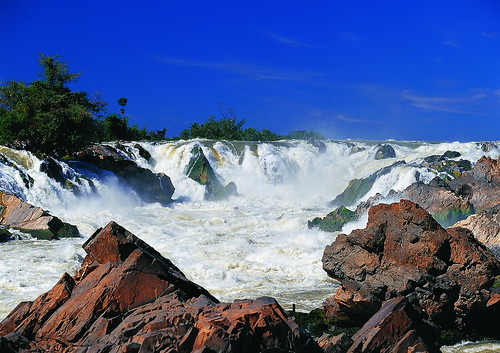
Planeta.com announces the winner of the 2008 Ecotourism Spotlight Award. For the second year in a row, Ecotourism Laos received the greatest number of votes.
"Thanks to all for supporting the Ecotourism Laos website and other great sites listed this year," said Steven Schipani, Senior Advisor of the Lao National Tourism Administration. "I would also like to thank Planeta for providing a platform to recognize the Lao Government's support for ecotourism and its efforts to conserve the country's rich cultural and natural heritage"
BACKGROUND
Government websites that educate visitors about ecotourism and responsible travel options are eligible to win Planeta.com's annual Ecotourism Spotlight Award. 2008 nominees included Laos, Quito and Bali and Utila.
The award was developed to create incentives for communication, opportunities for conversation and a reward for participation among government leaders working toward ecotourism and responsible travel.
"Many tourism officials are figuring out Web 1.0 principles as locals and visitors are seeking out the Web 2.0 experience," said Planeta.com founder Ron Mader. "The spotlight award helps nudge government leaders forward as we give credit to the websites that are leading the pack."
The winner is announced in celebration of World Tourism Day (September 27) as way of spotlighting best practice in responsible travel and ecotourism.
Voting took place from July 15-August 30. More than 100 people participated.
Source: http://www.planeta.com/planeta/08/0809spotlightaward.html
Ecotourism Laos Wins 2008 Ecotourism Spotlight Award !
 Better known by its former name, Burma, this once thriving British colony of teak forests is now a pariah state which has been under strict military junta control for four decades. That doesn't hide the fact that it has an incredible cultural legacy which attracts a small flow of tourists.
Better known by its former name, Burma, this once thriving British colony of teak forests is now a pariah state which has been under strict military junta control for four decades. That doesn't hide the fact that it has an incredible cultural legacy which attracts a small flow of tourists.What’s Cool
Multiethnic make up of the country, Yangon's Shwedagon Paya pagoda, Mandalay's historic attractions, the traditional lifestyle in Shan State, Bagan's hundreds of chedis, Bago's pagodas, handicrafts in Pathein.What’s Not
The human rights record of the junta, widespread poverty, areas off-limits to tourists, poor infrastructure, hot season temperatures, beggars and petty thieves, inadequate medical facilities, poor food hygiene and tropical diseases.When to Go
Best: November-FebruaryHigh season: November to February
Low season: May to September
Essential Info
Time: GMT+6 1/2Electricity: 230V 50Hz
Most 3-flat plugs (UK)
Money: Myanmar kyat
1US$ = 6.6 kyat (1,200 black market)
Phone: ICC (+95) Outgoing: 00
The people are welcoming, if somewhat subdued, and it's safe to travel here provided you stick to the government prescribed routes, don't talk politics to the locals and spend your overpriced foreign exchange certificates. Despite the depressing human rights situation and sheer poverty from isolation, the desperate locals will appreciate your visit.
Yangon is no longer the nation's capital, with the generals having moved politics to a more secretive location, yet it houses some of its greatest wonders - namely the She Pagoda. This sacred religious site is steeped in legend and a favorite with pilgrims. More Buddhist treasures can be admired at Bagan, with its sea of pagodas, and Mandalay, home to dozens of temples and a reconstructed royal palace.Myanmar is a country with contradictions both strange and sad. It’s blessed with huge amounts of natural resources and stunning beauty, but its population toils in poverty; its rich history and fabulous temples are a natural draw for millions of tourist dollars, yet it sees only a trickle of that potential.
If you do decide to go, and are prepared to deal with the risks and restrictions, Myanmar can be a breathtakingly beautiful country, with friendly people and endless splendor. One only hopes that the situation will improve, and the country will eventually be able to take advantage of all it has to offer.
Note: Many think that visiting Myanmar only provides a revenue stream that the government uses to continue repressing its citizens, while others say that visiting is an important way to support the locals by spending money at non-government businesses. It’s complicated, and serious research should precede any visit.
Travel to Myanmar - Getting There
Going to Myanmar is quite a challenging task for those who are only used to luxury. The most realistic means of reaching Yangon is from Bangkok, but flights also arrived from East India and Bangladesh, China, Malaysia and Singapre. You can also fly to Myanmar from Chiang Mai in Thailand. Yangon Airways provides domestic flights to key attractions around the country. Driving overland from India or Thailand is unrealistic due to restrictions and safety. A rail service will get you North to Mandalay with modest comfort and reliability. Trishaws, taxis and pick-up trucks can be flagged down anywhere in the country to take you places, they are run down but cheap..Myanmar Things to Do
- Yangon (Rangoon)
- The capital city of Myanmar on the Yangon River boasts many tourist spots such as the famous gold-plated Shwedagon Paya (pagoda), the reclining Buddha in Chaukhtatgyi Paya and the exquisite Kandawgyi and Inya Lakes.
- Mandalay
- This very Burmese, second-largest city in the country features Mandalay Hill, Mahamuni Paya with the ancient Rakhine Buddha image, and Shwenandaw Kyaung, the remains of the once magnificent palace from where the country was once ruled. Four abandoned cities nearby will please photography buffs.
- Shan State
- The infamous Golden Triangle, floating markets and many gardens can be found in Shan State as well as those long necked women you always see on the Discovery Channel.
- Bagan
- An ancient city, destroyed by Kublai Khan in 1287, packed with a number of pagodas and temples located on the charming banks of the Ayeyarwady River.
- Bago (Pega)
- Another ancient city worth visiting, Bago features interesting sights such as the Shwemawdaw Pagoda which dominates the town, the Hintha Gone Pagoda and the reclining Shwethalyaung Buddha.
- Pathein (Bassein)
- Known for its handicrafts and the Shwemokhtaw Pagoda, Pathein is worth a visit if you want to break away from the bustling city.
Myanmar Travel Guide

What’s Cool
Lavish seven-star hotels, amazing mosques, the royal palace of Istana Nurul Iman, water sports, low crime rate, excellent medical services, idyllic beaches.What’s Not
Hot and humid weather year round, alcohol is illegal, lack of budget hotels, severe punishment for offences, risk of tropical diseases.Visas
US/Can: on-arrival (90 / 14 days)EU/UK: on-arrival (14 / 30 days)
Aus/NZ: on-arrival (14 / 30 days)
Essential Info
Time: GMT+8Electricity: 220-240V 50Hz
3-square Pin Plug
Money: Brunei Dollar
1US$ = 1.46 B$
Phone: ICC (+673) Outgoing: 00
Once a British colony, Brunei is today a unique tourist destination where you can rub shoulders with ex-pat oil workers and orangutans. Located on the island of Borneo and bordering the Malaysian state of Sarawak, this city-sized country boasts a long-recorded history and unique culture.
A number of parks, lakes and countless architectural wonders including the gleaming gold dome of Sultan Omar Ali Saifuddien Mosque all add an interesting tourist spin to Brunei. The capital, Bandar Seri Begawan, has more than just beautiful mosques, however. It features a lively amusement park on its western outskirts and acts as a gateway to the port town of Muara and the oil towns of Seria and Kuala Belait.It is not the cities and towns that visitors come here for but the Temburong eco-tours and longhouse stays. Rainforest covers Belalong National Park, and here visitors can walk among the trees on the canopy walk before learning more about the huge insects and other wildlife that call the forest home at the research center.
If you've never been to Brunei then a good introduction is our Brunei Tourism page which gives an introduction to the country and an overview of all the essential travel, visa, health, safety and itinerary information needed by first-time travelers.
Brunei Travel Guide

(KPL) Laos and Malaysia have agreed to increase direct flights between Vientiane and Kuala Lumpur following an agreement between the Lao Aviation Transport Department and Malaysia Airlines.
Under the recently-signed deal, the number of direct flights will be increased from three to seven a week.
Laos will not limit the number of flights between the two countries, Viengsay Singkhama, Director of the Lao Aviation Transport Department, said, adding that they are non-stop flights without transit through a third country.-
Laos, Malaysia will have direct flight 7 days a week !
 Promoting itself as 'Malaysia truly Asia', this unique country is where you can shop, admire high technology and explore modern buildings one day and unwind on the beach or trek in dense jungles the next.
Promoting itself as 'Malaysia truly Asia', this unique country is where you can shop, admire high technology and explore modern buildings one day and unwind on the beach or trek in dense jungles the next.What’s Cool
Dazzling hi-tech Kuala Lumpur, Petronas Towers (formerly the world's tallest), gorgeous Langkawi, golden beaches and historical interest in Penang, colonial Portuguese buildings in Malacca, Trekking among Sabah's and Sarawak's fascinating plants and creatures, Genting's casino, nightclubs in KL, authentic Asian cuisine and observing interesting festivals.What’s Not
Mad traffic in Kuala Lumpur, air pollution, reckless drivers and motorcyclists, the heat, pickpockets, food that causes diarrhea, malaria in East Malaysia, bird flu, spiking in the clubs, illegal (unregistered) taxis.When to Go
Best: April-OctoberHigh season: June to August, December and January
Low season: February and March, September and October
Visas
US/Can: on-arrival (3 months)EU: on-arrival (3 months)
Aus/NZ: on-arrival (3 months)
Essential Info
Time: GMT+8Electricity: 220V to 240V 50Hz
3-Pin square (UK) Plug
Money: Malaysian Ringgit
1US$ = 3.59 RM
Phone: ICC (+60) Outgoing: 00
The mainland peninsula lets you enjoy a big city lifestyle while East Malaysia offers untouched nature and Survivor style adventures. Also a hub of gastronomic Asian cuisines and diverse cultures, Malaysia blends perfectly Malay, Indian, Thai and Chinese characteristics with a touch of western influence.
The trendy capital, Kuala Lumpur, is dominated by the Petronas Towers, a glistening reminder of the nation's modern developments. Glitzy shopping abounds here but things are more laid-back in other popular tourist centers like Malacca and Penang, where colonial architecture abound.The lesser visited Sabah and Sarawak offer unique explorations in national parks and rainforest with the chance to take in rare wildlife and the traditional ways of the ethnic groups that inhabit these parts of Borneo. You could of course head to the resort island of Langkawi on Malaysia's west coast for Andaman bliss instead.
Travel to Malaysia - Getting There
Malaysian Airlines connects Malaysia with many major countries in the world. You can fly to Kuala Lumpur International Airport and Penang Airport on the mainland peninsula or to Kota Kinabalu Airport or Kuching Airport in East Malaysia. From the airports, pre-paid taxis are widely available. The world's major ferry lines have a number of cruises to Malaysia while trains connect Thailand and Singapore to Kuala Lumpur. Those wishing to drive can enter Malaysia Peninsula via Thailand and Singapore. Getting around in the country is an easy task. You can fly, hop on a local bus, take a train or drive. The country has an excellent highway network and all roads are in perfect condition. Just watch out for reckless motorcyclists and remember to drive on the left.Malaysia Things to Do
- Kuala Lumpur
- This bustling capital city features countless modern skyscrapers including Petronas Twin Towers, one of the world's tallest buildings. Also an Asian hub of shopping and entertainment.
- Penang
- Known as 'Pearl of the Orient', this charming island of Malaysia is famous for its natural scenic beauty, golden beaches and the laid-back capital of Georgetown, with its British Colonial character.
- Langkawi
- An ideal tropical island escape with fine beaches, azure waters, upmarket resorts, incredible karst seascapes and a good tourist infrastructure that isn't overcrowded.
- Malacca
- With its architectural buildings influenced by the Portuguese and many tourist attractions such as zoos, farms, Mini ASEAN and Mini Malaysia.
- Genting Highlands
- In the populated Selangor state has become one of the top shopping destinations for Asian tourists, offering great bargains on brand-name goods. This hill-top resort town is also known for outdoor sports, golf course and casino.
- Cherating
- Is an ideal holiday getaway venue for jet-setters, located about 45kms from Kuantan. The beaches are some of the finest on the east coast, popular among windsurfers.
- Terengganu
- In the east coast is peaceful with a variety of quiet streets, small villages and unspoilt beaches. Home to the lilting Gamelan and the impressive traditional 'Ulek Mayang' dance.
- Sabah and Sarawak
- Located in East Malaysia on the tip of Borneo, these two states are home to orung-utans, the world's largest flower Rafflesia, flying squirrels and snakes, insect-eating plants and a variety of rich fauna and flora.
Malaysia Travel Guide
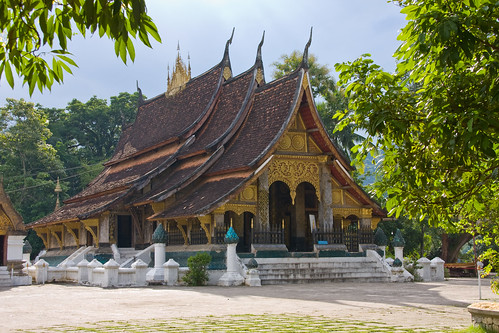
The Sydney Morning Herald describes Laos as the cheapest travel destination in Asia. It’s described as “living-like-a-king-on-the-cost-of-a-packet-of-chips-a-day" !
If you've already been to South-East Asia, you won't need me to tell you how great it is (although bear with me, I have to bang on about it for a second to everyone else).
The place has got pretty much anything you could want in a travel destination, save for maybe some snow.
For starters, it's extremely affordable, particularly now with the number of budget carriers flying there. And when you're there, things range from the cheap (Malaysia, Singapore), to the really cheap (Thailand), to the extremely cheap (Vietnam), to the ridiculously cheap (Cambodia) to the I'm-living-like-a-king-on-the-cost-of-a-packet-of-chips-a-day cheap (Laos).
To read more click HERE >>
Sydney Morning Herald ranks Laos as the cheapest destination 2009
Another Ilocos delicacy, besides Candon Kalamay, peddled on the streets of Vigan is the tinubong, so called as it derives its name from the container, a bamboo tube with an opening at one end and a node at the other, which locals (Ilocano) call tubong, thus the name tinubong. The tinubong comes stuffed inside bamboo poles of about an inch or two in diameter and about a foot in length.
 Tinubong beside Candon Kalamay offered by hawkers outside Baluarte
Tinubong beside Candon Kalamay offered by hawkers outside Baluarte
Tinubong is a sticky, sweet delicacy made from glutinous flour, sugar, coconut milk, small strips of buko (young coconut flesh) and sometimes cheese and margarine inserted into the bamboo tube then roasted over charcoal embers (traditionally) or in ovens (in commercial quantities).
 tinubong with the sweet stuff exposed when you split the bamboo tube.
tinubong with the sweet stuff exposed when you split the bamboo tube.
You can buy tinubong sold by peddlers, near the Baluarte, city plazas, and other Vigan pasalubong shops in the old heritage city for about PhP20.00 per tube depends on size and your haggling skills.
 Tinubong beside Candon Kalamay offered by hawkers outside Baluarte
Tinubong beside Candon Kalamay offered by hawkers outside Baluarte Tinubong is a sticky, sweet delicacy made from glutinous flour, sugar, coconut milk, small strips of buko (young coconut flesh) and sometimes cheese and margarine inserted into the bamboo tube then roasted over charcoal embers (traditionally) or in ovens (in commercial quantities).
 tinubong with the sweet stuff exposed when you split the bamboo tube.
tinubong with the sweet stuff exposed when you split the bamboo tube. You can buy tinubong sold by peddlers, near the Baluarte, city plazas, and other Vigan pasalubong shops in the old heritage city for about PhP20.00 per tube depends on size and your haggling skills.
Tinubong: Kakanin Inside Bamboo Tubes in Vigan, Ilocos Sur
Just to post about Tutubi's 20 minute visit to Chavit Singson's Baluarte in Vigan (actually part of Caoayan town of Ilocos Sur) before heading the long drive home.
Baluarte is becoming famous stopover for tourists visiting Vigan where people can see and interact with animals on display at the Chavit Singson's mansion cum mini-zoo, with animal interaction scheduled everyday with several wild animals (better left in the wild, Tutubi thinks) . Animals kept at the mini-zoo include pygmy horses, white deers, camels, tigers, various birds, ostriches, and snakes.
 Chavit Singson's Balwarte in Caoayan, Ilocos Sur
Chavit Singson's Balwarte in Caoayan, Ilocos Sur
 a dromedary (arabian camel with a single hump) shot around high noon
a dromedary (arabian camel with a single hump) shot around high noon
 a pair of white deers resting in the noon shade
a pair of white deers resting in the noon shade
After taking a few pictures, Tutubi sped off to Sta. Cruz town then went home.
---
Baluarte Show Schedules
Animal encounters
everyday 11am, 12nn, 4pm
Potbelly Painting: daily at 10am and 2pm
baluarte entrance fee/admission price: none, nada, gratis, free
parking: ample parking spaces, no parking fee
photography: no restrictions, no permits required to shoot
How to get to Baluarte, Caoayan, Ilocos Sur:
From Vigan city proper, just hire a tricycle to take you there, travel time is about 10 minutes. Consider asking tricycle driver to wait for you or pick you up at an appointed time
If you have your own car, just drive down inwards on Quirino Avenue (the street of Petron gas station on the highway) until you see the Caoayan welcome arch where you turn right (on the fork). Drive until you see the Baluarte artwork then choose the right fork (if you missed it and chose left, you'll end up at the Hidden Garden of Vigan)
Coordinates: N17 33 02.1 E120 22 39.1 (useful if you have GPS navigator).
Open Street Map here (trivia: much of Vigan's map, as of posting time, was added by Tutubi with data gathered by his GPS going around Vigan)
Baluarte is becoming famous stopover for tourists visiting Vigan where people can see and interact with animals on display at the Chavit Singson's mansion cum mini-zoo, with animal interaction scheduled everyday with several wild animals (better left in the wild, Tutubi thinks) . Animals kept at the mini-zoo include pygmy horses, white deers, camels, tigers, various birds, ostriches, and snakes.
 Chavit Singson's Balwarte in Caoayan, Ilocos Sur
Chavit Singson's Balwarte in Caoayan, Ilocos Sur a dromedary (arabian camel with a single hump) shot around high noon
a dromedary (arabian camel with a single hump) shot around high noon  a pair of white deers resting in the noon shade
a pair of white deers resting in the noon shade After taking a few pictures, Tutubi sped off to Sta. Cruz town then went home.
---
Baluarte Show Schedules
Animal encounters
everyday 11am, 12nn, 4pm
Potbelly Painting: daily at 10am and 2pm
baluarte entrance fee/admission price: none, nada, gratis, free
parking: ample parking spaces, no parking fee
photography: no restrictions, no permits required to shoot
How to get to Baluarte, Caoayan, Ilocos Sur:
From Vigan city proper, just hire a tricycle to take you there, travel time is about 10 minutes. Consider asking tricycle driver to wait for you or pick you up at an appointed time
If you have your own car, just drive down inwards on Quirino Avenue (the street of Petron gas station on the highway) until you see the Caoayan welcome arch where you turn right (on the fork). Drive until you see the Baluarte artwork then choose the right fork (if you missed it and chose left, you'll end up at the Hidden Garden of Vigan)
Coordinates: N17 33 02.1 E120 22 39.1 (useful if you have GPS navigator).
Open Street Map here (trivia: much of Vigan's map, as of posting time, was added by Tutubi with data gathered by his GPS going around Vigan)
Chavit Singson's Baluarte in Vigan/Caoayan, Ilocos Sur
The tourism sector in Bokeo province will undertake three development projects to attract visitors to stay longer in the province in coming years.
The tourism department will develop a hot spring and create tourist villages in Tonpheung district in the north of the province, an area that forms part of the Golden Triangle between Laos , Thailand and Myanmar .
Department Director, Mr Vanthong Chittakoun, this week said the department also planned to organise tourist activities including camping and kayaking in the Nam Nhon river in Houayxai district.
Other plans for the area include eco-tourism development in the area of Phouxifa mountain in Paktha district. The main tourist activities there will include rock climbing, camping and trekking.
Mr Vanthong said the Asian Development Bank had agreed to provide financial support and he expected the projects to begin in 2009.
Bokeo currently serves as a gateway for tourists who are travelling across the Mekong River to or from Chiang Rai province in Thailand .
“Of all the tourists who come to the province 80 percent of them will get on a boat and go to other provinces,” Mr Vanthong said.
A lot of tourists visit Bokeo, but most of them do not stay there because of the lack of tourist facilities. The city is currently just a transit route for visitors on their way to places such as Luang Namtha and Luang Prabang provinces, and Pakbaeng district of Oudomxay province.
A guesthouse manager in Houayxai district told Vientiane Times that many of his guests arrived via the Mekong River from Thailand and most stayed for only one night.
Bokeo has a lot of attractive tourist sites such as the Nam Nhon waterfall, hot springs and hill villages, but few of them have been developed or promoted.
Mr Vanthong said the province currently had few visitor attractions, although there was a nature tourism site in the Namkan conservation area, managed by a French investor.
This site is about 80km from the province's capital city Houayxai.
Another attraction is Donxao island in Tonpheung district, which is about 50km from the provincial capital. Many of the tourists who cross the Mekong River at Chiang Saen in Chiang Rai province stop at the island to buy souvenirs and handmade products.
More than 88,000 tourists have visited the province this year, an increase from the 20,000 visitors last year, according to statistics from the provincial tourism sector.
Vientianetimes
Bokeo plans to attract more tourists !

What’s Cool
Incredible temples, beauty and culture of Bali, the unspoilt islands and beaches of Lombok, exploring the jungles of the islands in the east, seeing Sumatra's orangutans and the ancient temples of Yogyakarta.What’s Not
Anti-western sentiment, Islamic extremists, bombings, the legacy of the tsunami in Aceh, hot humid weather, pollution and noise of Jakarta, coming face-to-face with a komodo dragon!When to Go
Best: May-SeptemberHigh season: July to August
Low season: October to March
Essential Info
Time: GMT+7Electricity: 220V 50Hz
Round two-prong European plug
Money: Indonesian Rupiah
1US$ = 10,200 RP
Phone: ICC (+62) Outgoing: 001
Despite two devastating bombings, Bali continues to attract tourists as one of Asia's most popular resort island destinations, and rightly so. Even more travelers make it to Borobudur, an ancient temple complex that rivals Cambodia's Angkor Wat as the largest Buddhist temple in the world. Jakarta may be the capital, but its congested streets have little to keep visitors lingering.
Diving fans may like to check out Sulawesi, a diverse destination with world class reefs. But there are plenty of great dive sites near the more popular Bali and Lombok for the less adventurous. Jungle and volcano trekkers, on the other hand, have endless possibilities in the rugged wilderness that spans much of the country.Indonesia has reasonable domestic air service but safety can be dubious. A cheaper way to traverse this island-nation is to travel by boat, or by train if you're on Java or Sumatra. Driving habits leave a lot to be desired so watch your back.
Travel to Indonesia - Getting There
Jakarta and Denpasar (Bali) have only two long-haul international airports and are the most realistic entry points. Getting around is tricky due to the sheer geographical size and spread, therefore flying is the best option, with numerous local routes. Ferries connect Sumatra, Java, Bali and Lombok, with lesser sailings to Sulawesi and Kalimantan. Local buses run across the length of each island; they are fairly frequent but slow and hardly comfortable. On Java, you have the choice of VIP minibuses for a hassle-free journey as well as a train service.Indonesia Things to Do
- Yogyakarta
- This stately Java city is full of handsome attractions, but mostly serves as a base to visit the Prambanam Hindu temple complex and the ancient site of Borobudur.
- Bali
- Recovering from the bombings, this paradise-like island of peaceful and friendly locals, perfect beaches and dramatic scenery was once a popular packaged destination and the jewel in the country's tourism crown. Expect plenty of beer-drinking Aussie blokes and sheila's mate!
- Lombok
- The next island east of Bali is where you go to escape the tourists, best appreciated on a chartered boat. Picture beaches all to yourself, azure waters and white sand.
- Bukit Lawang
- Bukit Lawang is a national park on Sumatra, 90kms northwest of Medan, in which adventurous travellers make a bee-line to seek out the orangutans and enjoy trekking, river tubing and a natural environment.
- Lake Toba (Danau Toba)
- Lake Toba is a gorgeous lake on Sumatra formed in a volcanic caldera, with a wedged-shape island from the collapsed cone offering all sorts of leisure locations.
- The lakes of Kelimutu
- The lakes of Kelimutu are one of the main attractions on Nusa Tengara, with multi-coloured waters formed in volcanic craters that seem to change like a kaleidoscope. Bizarre and unique.
Indonesia Travel Guide
 A country of rich cultural heritage and spectacular natural scenery, Cambodia has a sad recent history from which it is still picking up the pieces. From the former heights of the mighty 10th century Angkor Kingdom to the lows of Pol Pot's murderous regime that wiped out a quarter of the population, Cambodia has had an eventful past.
A country of rich cultural heritage and spectacular natural scenery, Cambodia has a sad recent history from which it is still picking up the pieces. From the former heights of the mighty 10th century Angkor Kingdom to the lows of Pol Pot's murderous regime that wiped out a quarter of the population, Cambodia has had an eventful past.What’s Cool
Angkor Wat, glitzy casinos, Sihanoukville's empty beaches, Phnom Penh's vibrant backpacker scene, Mekong Island's wildlife, dolphin spotting in Kratie, cheap hotel rates, interesting museums tracing Cambodia's tragic modern history.What’s Not
Widespread prostitution and poverty, unexploded ordinance, scams, hot and humid weather for most of the year, occasional violence and political tension, unreliable transport, pot holes, lawlessness and firearms.When to Go
Best: March-AprilWorst: November-December
Visas
US/Can: no (30 day)EU: *no (30 days)
Aus/NZ: no (30 days)
Essential Info
Time: GMT+7Electricity: 220V 50Hz 3-Pin Plug
Money: Baht: 1US$ = 32 Baht
Phone: ICC (+66) Outgoing: 001
Cambodia might be quite low-key compared to its more popular neighbor, Thailand, yet it has plenty of charms of its own. With ancient temples, fascinating ruins, peaceful beaches and the very touristy Angkor Wat, Cambodia is slowly making its way to becoming one of the more popular destinations in Southeast Asia.
The capital, Phnom Penh, caters well to backpackers with its budget lodgings and lively bars while the likes of Siem Reap have more upscale offerings to cater to the increasingly sophisticated Angkor Wat crowds. The macabre Killing Fields are a sombre reminder of the nation's turbulent past but essential viewing for anyone who wants to get to grips with Cambodia's turbulent modern history.Travel to Cambodia - Getting There
The fastest way to arrive in Cambodia is by air. The airport in Phnom Penh receives flights from Bangkok, Singapore, Kuala Lumpur, Hong Kong, Ho Chi Minh City and Guangzhou. From the airport, local buses are provided to take you to your destinations while taxis are aplenty at the airport and in the city. There are also frequently flights to Siem Reap from Bangkok, Chiang Mai, Pattaya and other regional airports - for convenient short trips to Angkor Wat. Alternatively, you can reach Cambodia by waterway from neighboring countries. The country's international seaport is located in Sihanoukville. To get around, use the services of trishaws and taxis. The road network is in a poor state and land transport is both tedious and uncomfortable.Cambodia Things to Do
Angkor Wat
- Siem Reap acts as the gateway to the world-renowned temples of Angkor, a true wonder of the world and the remains of an ancient Khmer city and religious center. The nearby Bayon and Ta Prohm temples are also worth visiting.
- Phnom Penh
- Many outstanding colonial architectural wonders, old temples, the National Museum, the Silver Pagoda, and busy streets attract tourists to Cambodia's capital city where unique historic charms fill the air.
- Mekong Island
- Visit a small zoo and weaving villages. Befriend big, friendly elephants and explore the island on their backs.
- Sihanoukville
- This resort town in the south boasts tranquil beaches, several natural spots such as waterfalls and rolling hills, and is a great place to relax with plenty of peaceful resorts.
- Battambang
- Cambodia's second-largest city, about 290kms from Phnom Penh, features many temples and villages. A small museum displays a selection of Angkor-era artifacts while a large lake is an ideal place for relaxing amid nature.
Cambodia Travel Guide
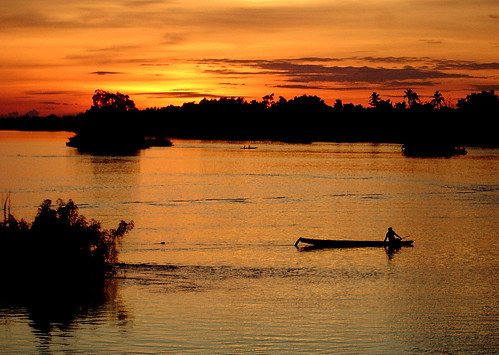
When Laos began to truly open to tourism in the early 1990’s, visitors focused on the cultural riches of Luang Prabang in the north, and the southern regions remained for a long time a destination for the more adventurous travelers. But this is changing fast. With the remarkable improvement of road networks around the whole of Indochina, Champasak has become the center of a new buoyant backpacking scene commuting overland in luxurious sleeper buses between Vientiane and Phnom Penh. And with a bridge crossing over the Mekong that links Thailand and Vietnam along the east-west axis, getting across borders is now much easier.
Sand Bar Islands

Mention visiting an island in Laos and one will most likely meet with a perplexed gaze. The very idea of islands in Southeast Asia is so indubitably linked to visions of white sandy beaches, that it simply cannot fit Laos, a largely mountainous country with no direct access to the sea. But rivers too can harbour islands, and in the case of Laos, one has to take into account that the Mekong isn’t just any ordinary river. It is one of the longest rivers in the world, and the possibility of it giving rise to islands shouldn’t be regarded as impossible. However, the Lao name Si Phan Don, or Four Thousand Islands, that was bestowed on the lush and scenic Champasak province in Southernmost Laos is a little superlative, if not far-fetched. To meet with such an incredible number of islands, one has to take into account every single sand bar that emerges out at the peak of the dry season. That said, there are indeed a good number of islands inhabited all year round, the largest of which, Don Khone, measures no less than four-by-eight kilometers. At the height of the rainy season, some parts of the Mekong in Si Phan Don can span over 12 kilometers. This is also where the river suddenly drops in altitude, resulting in the formation of a few majestic waterfalls that have prevented thorough commercial use of the Mekong. One of these waterfalls, Khon Pha Pheng, is purpotedly the largest waterfall in Southeast Asia and, indeed, the impressive tumultuous flow of water stands as a stark reminder that the Mekong is also the 12th largest river of the world by volume.
The Two Dons
The islands of Si Phan Don are best explored by bicycle, cycling on sandy shaded paths across the forests or along the luxuriant river banks. Most activity takes place on the twin islands of Don Det and Don Khone, which are linked by a concrete bridge. This bridge was part of a train track built by the French to link Don Khone’s southernmost point and Don Det’s northern bank in an attempt to bypass the waterfalls and allow the transportation of goods on the Mekong. A short distance away from the bridge lies a rusting tiny locomotive that for many years commuted along the only railway track ever built in Laos. Don Det has attracted the younger segment of the backpacking scene, bringing a distinct hippy flavor to the place. Typical accommodations here take the form of hammocks hanging in the bungalows veranda, with a view over the river of course. The more comfortable accommodations are found in Don Khone. An interesting option is Sala Phae (Ban Khone Tai, Khong District, Champassak Province, +856-30-525 6390, +856-21-217 526, www. salaphae.salalao.com), which has floating raft rooms, where you can sleep in a large breezy room directly over the flow of the mighty river, watch the sunset from the veranda, and dip your feet in the cool water of the Mekong.
Pakse Crossroads
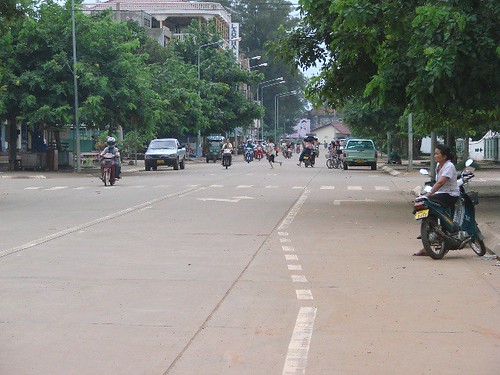
Si Phan Don, however, is only one of the many attractions that Champasak has to offer. The once sleepy little town of Pakse is right in the middle of the Indochina backpacker trail, and seems bent on becoming an important crossroad. In fact, judging by the number of luxury hotels under construction around town, Pakse has already become an attractive destination for a number of investors. Pakse too has its fair share of quaint colonial buildings from the turn of the 20th century which are an interesting combination of Art Deco and 1950’s architecture. Particularly arresting is a block of shophouses where one can see a clear chronological evolution of urban Southeast Asian architecture over the entire 20th century, from French colonial to 1990’s Post-Modern and Neo-Classical styles. And, with a scenic location at the confluence of the Mekong and the Se Don River, Pakse is actually quite a pleasant place to visit.
The Bolaven Plateau
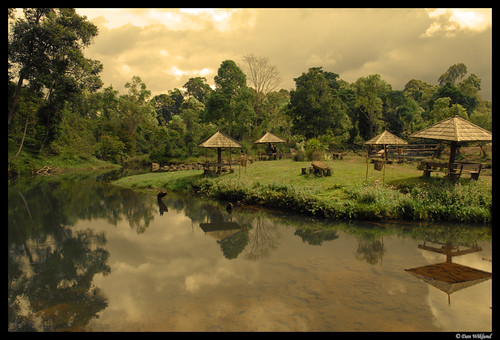
Just one hour north of Pakse, with an altitude of around 1,000 meters, the Bolaven plateau was put to good use by French planters to cultivate coffee and tea. Today, a large quantity of the production is exported, and is one of Laos’s most important sources of foreign trade. This is the place to find cool air and nature at its best. Ecotourism has become a catch word in Laos, heavily encouraged by local authorities, and the Bolaven plateau has a lot to offer. You can enjoy scenic rides across forests, coffee and tea plantations; hop from one pretty waterfall to the next, stop in hill tribe villages to buy intricate hand-woven textiles or take the obligatory elephant ride. More adventurous travelers can rent motorbikes to explore the plateau on their own. The Bolaven plateau also has a few atmospheric accommodation options to offer in the form of bungalows overlooking cool waterfalls.
The Ruins of Wat Phu

Champasak is home to one of the oldest Khmer sites in existence—the ruins of Wat Phu. The origin of this temple is found in the shape of the mountain at the foot of which the temple started taking shape in the fifth century CE. The summit, the Phu Kao, immediately commands ones attention because of its resemblance to a linga, Shiva’s phallic symbol. Phu Kao was believed to be a natural linga, a spontaneous manifestation of the Hindu god. At the foot of the mountain, fl owed a spring, around which the temple was built. Later in history, that spring was used to keep the linga of the sanctuary perpetually wet, a set-up apparently unique to the Khmer world. Wat Phu presents fine examples of Khmer sculpture and is best visited in the early morning when the frangipanis lining the staircase leading to the sanctuary pervade the air with their heavenly smell. In order to be there in time for sunrise, it is best to stay in the nearby little town of Champasak that gives its name to the province, which was previously the capital of a short-lived, 18th century kingdom that has lost most of its former glory. There are a few guesthouses of fairly good standard. The best and most romantic option is La Folie Lodge (Don Daeng, District Pathoumphone, BP 668, Champassak, Lao PDR., 856-534-7603, reservations@folie-laos.com), a resort complete with swimming pool overlooking the Mekong and finely decorated teak bungalows set in the lush greenery of the island of Don Daeng. As the whole of Indochine opens up ever more to tourism, there will be fewer and fewer places like Champasak left to explore. Go now.
Source: AziaCity.com
Champasak: Laos’s New Destination !
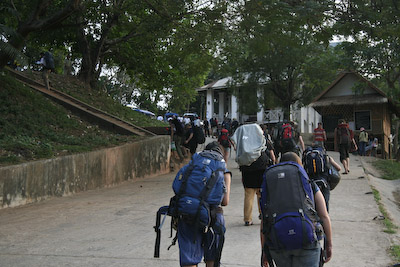
(KPL) A tourism information center was built recently in Parkbeng district with 287 million kip of government fund.
The center was considered as the main potential for attracting the tourist and helping them to save the time to looking for the tourist sites in the province.
In the first six months of 2007-2008 period, the Parkbang district has received 24,548 tourists, 1,140 of which was local tourists and 23,307 foreign tourists with able to create income about 6.137 billion kip.
To day, the Parkbeng district has one hotel, 2 resorts and 13 guesthouses with 216 rooms and 20 restaurants.
Tourism information center built in Pakbeng district, Laos
Welcome to Laos to watch the following story of Luang Prabang, the world heritage site.
Luang Prabang, the best preserved city in Southeast Asia
A landlocked Asian country of mountainous wilderness in the north, dense jungle in the east and the mighty Mekong River in the west and south, Laos is an unspoiled, largely rural country. Although this communist land remains among the world's poorest nations, Laos offers a glimpse into a timeless and forgotten Asia.
What’s Cool
Floating down the Mekong on an inner tube, Luang Prabang's hundreds of temples, the mysterious Plain of Jars, French style baguettes and Lao coffee, boating around the 4,000 Island, Vientiane's Morning Market, the lush forests of the Bolaven Plateau, the slow pace of life.What’s Not
Old and unreliable buses, pot holes the size of a car, towns that seemingly go to bed at sunset, dust, scorching temperatures in the hot season, unexploded ordinance, poor food hygiene.When to Go
Best: October-FebruaryHigh season: November to February, April
Low season: June to October
Visas
US/Can: on-arrival (15 day)EU: on-arrival (15 days)
Aus/NZ: on-arrival (15 days)
Essential Info
Time: GMT+7Electricity: 220V 50Hz
2 prong round or flat pins
Money: Lao Kip
1US$ = 8,400 Kip
Phone: ICC (+856) Outgoing: 00
Precious hidden gems including temple-clad Luang Prabang and the old-fashioned capital city of Vientiane as well as many historical and natural wonders make Laos a cheap and newly popular destination for adventurers. The busiest tourist hotspots have seen old colonial mansions come back to life as boutique hotels while restaurants have cashed in on the French connection.
Travelers wishing to get off the beaten track of this slow-moving country can head for the mysterious Plain of Jars, a protected landscape dotted with huge jars carved out of stone, the origin of which is debated. Adventurous travelers should think twice about straying too far off the tourist track however, as unexploded ordinance from the Vietnam War era still plagues the nation.Travel to Laos - Getting There
There are flights connecting Vientiane's Wattay Airport to Bangkok, Ho Chi Minh City, Phnom Penh, Yangon and Kunming . Alternatively there is a service from Chiang Mai to Luang Prabang. Vientiene is also easily accessible by bus and train from Bangkok via Udon Thani. Catching the boat down the Mekhong from Northern Thailand is a popular adventure. Within the country buses are the only transport options, they are slow and hardly comfortable but usually make it over the mountainous terrain.Laos Things to Do
Luang Prabang
- Charming former capital, now a UNESCO World Heritage site boasting many beautiful Buddhist temples, French-era colonial houses and must-visit spots such as Phusi - a steep hill overlooking scenic views of the town - the Royal Palace Museum and Wat Xieng Thong, a fine example of Lao architecture.
- Vientiane
- Low-key capital city features an array of historic buildings including That Luang chedi and temple complex, (the national symbol of Laos), the Pataxi - a neo-Arch de Triomphe, Wat Sisaket and Wat Haw Pra Keo.
- Champasak Province
- Cruise down the Mekong and explore the 'four thousand islands' at the river's widest point, or hire a three-wheeled tuk-tuk to explore the town which was once a part of the Khmer Angkor Empire.
- Vang Vieng
- Cool stopover en-route south to Vientiene, popular with backpackers for its free-spirited atmosphere, impressive hilly backdrop, lazy river and exciting caving.
- Muang Sing
- Home to Laos' most colorful hill tribe people as well as several opium dens.
- Plain of Jars
- In the country's centre is scattered with bizarre massive ancient jars, the origin of which has baffled many.
- The Bolaven Plateau
- In Saravan, boasts gorgeous waterfalls and lush forests, the small market here is worth a visit.
Laos Travel Guide
Discover the Jewel of the Mekong river, Laos, by the Lao National Tourism Administration
Laos, the Jewel of the Mekong river (Official video 2008)
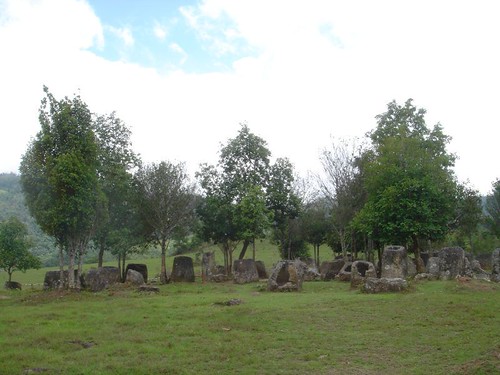
Xieng Khuang provincial authorities are hoping to open the door to the province's tourist attractions with two important new keys.
The first is the promotion of the Plain of Jars as a World Heritage Site in 2010 and the second is the construction of an international airport.
Xieng Khuang provincial Tourism Department Director, Mr Khamphet Phommadouangkaison, said “Our province has two big keys to open the door of worldwide tourism promotion.”
“Our vision for the development of our tourist attractions is to make changes in a logical way and follow the slogan ‘a smoke-free tourist industry',” he added.
“The province ranks tourism as second in importance to livestock rearing in its development master plan.”

“At present we are working on documents relating to the Plain of Jars which we will send to the United Nations Educational, Scientific and Cultural Organisation (UNESCO). We hope to have finished all the documents soon and they should be approved by UNESCO by 2010,” Mr Khamphet said.
“We plan to upgrade the provincial airport to an international airport in the near future. The project is now under discussion and we will send a project proposal to the government.”
Another of the province's plans is to develop the 750ha hill on Koud Mountain in Phoukoud district into a new tourist attraction, with a possible opening in 2009.
The Acting Governor of Xieng Khuang province, Mr Viengthanom Phommachanh, said last week the airport expansion would be financed by a loan from a neighbouring country worth about US$50 million.
He said this development would start in the near future because it was very important in bringing more tourists to the province.
“If we have better transport facilities we will get more tourists here. Most of them want to make short trips to local areas of interest so they have more time to spend at the site they visit,” Mr Viengthanom said.
According to a report from the Xieng Khuang provincial Tourism Department, there are actually 1,900 jars scattered over 52 sites, but only three sites are open to the public - two in Kham district and another in Khoun district.
The province has 14 hotels and more than 40 guesthouses.
Most visitors to the province come from Europe, with the rest coming mostly from Japan , China , Vietnam and Thailand .
By Sisay Vilaysack
Vientianetimes
Plain of Jars to become new World heritage site in 2010

Laos' old capital of Luang Prabang won a World No Tobacco Day Award from the World Health Organization (WHO) for its efforts to make the city smoking-free, the The Southeast Asia Tobacco Control Alliance said Friday.
"The Laos People's Democratic Republic, has once again proven their commitment to this global health treaty", alliance director Bungon Ritthiphkdee said, referring to the WHO Framework Convention on Tobacco Control.
"Without the close cooperation between government and civil society, the implementation of Smoke-free Luang Prabang would not succeed," she added. Luang Prabang was the royal capital, and seat of the Lao monarchy until 1975, when Laos went communist. City officials initiated the smoke-free program in March 2007, after the former capital was declared a UNESCO World Heritage site.
The smoking ban applies to all tourist attractions, government workplaces, private areas such as restaurants, guest houses, hotels, internet shops, handicraft and souvenir shops, and public places such as the night market.
Laos' old capital of Luang Prabang won a World No Tobacco Day Award from WHO

Khone Phapheng waterfall in Champassak province has earned more than 350 million kip for provincial tourism authorities over the first five months of 2008, according to a tourism official.
“Eighty percent of visitors to the waterfall are from Thailand and Europe and the rest are tourists from other provinces in Laos ,” Khone Phapheng waterfall tourism official Sisavath Bouapaseuth said yesterday.
He said the money received was from entry fees to the waterfall, which are 3,000 kip for Lao nationals and 10,000 kip foreigners.
Many tourists visit the cascade just before the rainy season because it is the best time of year to view the waterfall.
“Most tourists schedule a visit to Khone Phapheng before or after going to Vat Phou because these are the best natural and cultural tourist attractions in Champassak province,” Mr Sisavath said.
He said the numerous handicraft stalls and restaurants at the waterfall also benefited from the growing number of tourists.
A tourist from Thailand , Mr Bounta, who visited the waterfall last week, said the site was so beautiful he took almost 500 photos to show to friends and family in Bangkok .
Another visitor from Vientiane , Ms Nilanda, suggested authorities set up more handicraft stalls in the area to promote traditional Lao products.
Khone Phapheng waterfall is considered the largest by volume in the Southeast Asia region. Amongst the fall's many channels and rocky outcrops visitors can view local people going about their daily work, including setting fish traps.
“Due to the increasing number of tourists, we are doing what we can to protect the environment. We have installed rubbish bins and urge visitors to consider the impact they have on the site,” Mr Sisavath said.
He said almost 50,000 people had visited the falls so far this year and believed these figures would continue to increase in the future.
By Souknilundon Southivongnorath
Vientianetimes
Khone Phapheng waterfall in southern Laos draws thousands

(KPL) The construction of Savanh Vegas Hotel and Casino Project in Savannakhet province is expected to be completed and operate in early September.
The statement was disclosed at a meeting between the Investment Promotion Department and the Chinese Sanum Investments Ltd, owner of the investment project, in Savannakhet province on 9 May. Savannakhet Governor Mr Vilayvanh Phomke was also on hand.
Commencing in late 2007, the construction made in the village of Nongdeun, Kaysone Phomvihane district, is now 70 per cent completed.
The developer of the project is also conducting a survey and preparation for a similar project in Paksong district, the southernmost province of Champassak.
The President of Sanum Investments Limited Benson Ko said early this month the investment projects in Savannakhet and Paksong, Champassak, were considered significant contribution to the national economic development. Both projects cost US$50 million with the government of Laos holding 20% of the shares.
Upon completion, Paksong-Vegas Project is expected to attract more foreign tourists, as it is considered the biggest five-star spa and resort in Asia.
Savan Vegas Hotel and Casino in Laos to open soon
The shopping hub of Southeast Asia, plucky Singapore is a tiny island state with an enormous sense of achievement. Comprising of four main ethnic groups, it boasts grand colonial architecture, a Chinese work ethic, Malay cultural influences and a Tamil character, all blended as finely as a steaming laksa curry.

What’s Cool
The symbolic Merlion statue, wining and dining along the Singapore River, taking the family to Sentosa Island or the Night Safari, shopping on Orchard road, cultures of four different ethnic groups that make up the population of organised and friendly locals.What’s Not
Hot and humid weather, expensive hospitality, Singapore's infamous petty fines obsession.Essential Info
Time: GMT+8Electricity: 220V to 240V 50Hz
3-Pin squar plugs (UK)
Money: Singapore Dollar
1US$ = 1.46 S$
Phone: ICC (+65) Outgoing: varies
Sensible planning and efficient determination has created a great value-for-money tourist destination with plenty of family attractions, great shopping and good infrastructure. And it's not all high-rises either, but hardly backpacker budget-friendly. Sentosa is a great escape from the concrete jungle with its pretty beaches that sit in contrast to Orchard Road's megamalls.
Gastronomes will find themselves in heaven in the ethnic pockets of Little India and Chinatown while brain boxes can amuse themselves in Singapore's top museums. Real nature is few and far between today but not to worry as Singapore has re-created wild habitats at the city's night safari and zoo. But the real draw to this tiny city-state is its shopping so be sure to keep tabs on any ladies in your party.Travel to Singapore - Getting There
The island's extensive and uncongested highway system is managed by a complex automatic vehicle toll fee radar technology that's set up for local commuters. It's too small to think about hiring a car really and the Mass Rapid Transportation (MRT) rail system reaches all urban areas, backed up by efficient buses. Getting around is no problem and Changi International Airport is one of the world's most efficient as wellas being a hub for Asia. Taxis are surprisingly affordable too.
Singapore Things to Do
- Colonial district
- A legacy of centuries of British rule, the area north of the Singapore River is a jolly civilised suburb of grand old buildings centred around the Padang, a former cricket field.
- Chinatown
- Chinatown is a colourful district that hides in the shadows of the modern highrises, where the clack of mah-jongh tiles continues to epitomise the unchanged lifestyle in this area of bargain electronics shopping and Cantonese cuisine.
- Sentosa Island
- Sentosa Island is the jewel in Singapore's tourist crown, a leisure island east of the city that is packed with amusement parks, manmade beaches, golf courses and family attractions.
- Riverfront and Fort Canning
- Dividing the city centre in two is the stout Singapore River. It's a wonderful stroll from the iconic Merlion statue at the river mouth, past the trendy restaurants of Boat Quay and onto the after-work bars of Clark Quay, before climbing Fort Canning on a hill nearby for a view of the city.
- Little India
- Little India is a calamity of sights, smells and shopping as migrant Hindu workers flock to the suburb on their days off for cheap curries, Bollywood movies and the pungent scent of home. A heady and altogether different Singapore experience.
Singapore Travel Guide

Photo: Nang Sangkan (Miss Lao New Year 2008 in Luang Prabang, Laos)
Luang Prabang has estimated the number of both domestic and foreign visitors entering the province during Lao New Year celebration at 22,000.
“Foreign tourists will share over 70 per cent of the total visitors of the province during the celebration of Lao New Year,” said this week the Head of Luang Prabang Tourism Office, Mr. Khamtanh Somphanvilay.
The province also estimates that around 4 billion kip will be in circulation during the celebration.
“This year the province cerebrates Lao New Year from 9 to 19 April, and there will be so many activities than ever,” added Mr. Khamtanh.
A trade fair of domestic and foreign products and services also coincides the celebration of Lao New Year.
Source:kpl
photo: lpb2d
22,000 to celebrate Lao New Year in Luang Prabang !
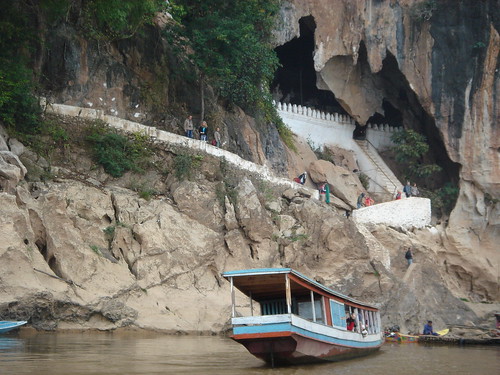
Photo: Ou cave in Luang prabang, Laos.
Travellers have always made lists of the top destinations to be visited in the world and even armchair travellers dream of experiencing the most unique and exciting sites the planet has to offer.
Bruce Poon, the founder of adventure travel company GAP Adventures, shares his top ten tourist places to see in your lifetime.
Here is what he said about Laos.
The magnificent ancient caves of Pak Ou in Laos are set high above the Mekong River some 25km from Luang Prabang.
These caves have been a place of Buddhist worship and solitude for more than 600 years and more than 4,000 images of the Buddha have been placed inside them over that time.
A humbling place to ponder life's greater mysteries and Mr Poon said that experiencing the tranquillity of these caves is something he will always cherish.
More info about this article can be found at
http://www.travelbite.co.uk/feature/south-and-central-america/venezuela/top-ten-places-see-in-your-lifetime-$1217114.htm
Top ten places to see in your lifetime, Ou cave in Lunag prabang on the list !
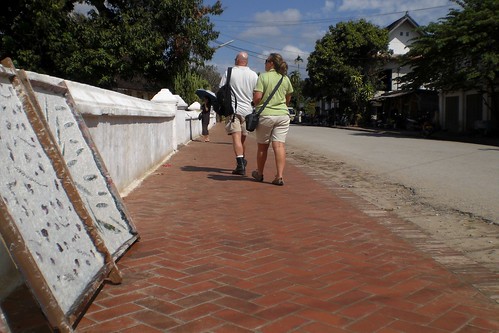
Laos is unique in that for a socialist country it has opened its doors to tourists. Since the latter part of the 1990s, Laos has been happy to welcome visitors from all over the globe. The reason behind their campaign to attract tourists, “Visit Laos” was because the economy was in a downward spiral and it was thought that tourism dollars would help to boost the economy. Lucky travelers can now experience the wonder of the sights and sounds of Laos.

Khone Phapheng is the largest waterfall that can be found in Southeast Asia. Located at Si Phan Don at its southern end, it is also considered home to Irrawadaddy dolphins, a rare species. The waterfall is a stunning sight and the presence of the dolphins makes it even more so. Day trips for viewing the dolphins often include a visit to Khone Phapheng.

Another important sight in Laos is Pha That Luang. Not only is this monument important for its relation to the Buddhist religion, it is also a monumnet to the sovereignty of Laos. Looking upon it from a distance, it gives the impression of a cluster of gilded missiles. In the early part of November, the temple is the location of one of Laos’ major festivals.

Pak Ou Caves can only be reached by boat and one can be caught at Ban Pak Ou. It is a spectacular sight as the setting is carved into a cliff made of limestone that faces the river. Inside the cave there are a plethora of images of Buddha in every style and shape, but many of them represent the classic standing Buddha, Luang Prabang. Tours are easily arranged by tour operators as well as many of Laos’ guest houses.
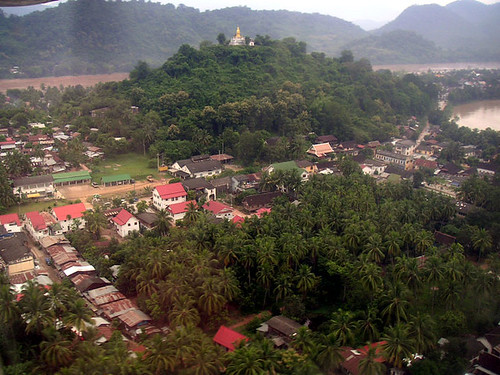
Other popular places to visit in Laos are the cities of Vientiane and Luang Prabang. Luang Prabang was given the distinction of being honored as a Unesco World Heritage city for its stunning, tranquil natural surroundings as well as its unique and beautiful architecture. This city is one of the top tourist destinations in Laos.
Source: www.traveling-blog.com
The Sights and Sounds of Laos
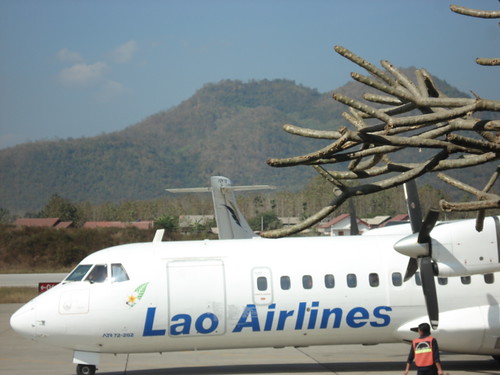
Officials from Laos and Japan will conduct a feasibility study of direct flights between Nagoya Airport in Japan and Wattay International Airport in Vientiane.
The Director General of the Civil Aviation Department, Mr Yakua Lopangkao, told Vientiane Times yesterday that Lao officials will first collect basic information regarding potential passenger demand.
“We expect to collect the information within the next two months and then we will send it to Japan,” he said. “We will meet with Japanese officials a month later.”
Mr Yakua observed that more people are flying from America and Japan to Indochina, especially to Laos.
Mr Yakua said that last year Prime Minister Bouasone Bouphavanh visited Japan and met with his Japanese counterpart to discuss various areas of cooperation. One of the issues discussed was the possibility of a direct flight from Nagoya to Vientiane.
Laos has direct flights to several countries, including Thailand, China, Cambodia and Vietnam. Air Asia started direct flights from Kuala Lumpur, Malaysia , late last year.
A flight between Laos and Singapore is also under consideration, Mr Yakua said.
“Last month, we had meetings with representatives from airlines in Singapore who told us they needed a more detailed survey before any developments could take place,” he added.
A direct flight to Myanmar is also under discussion, as officials believe such a move could boost tourism in the region.
“Our government has an open policy concerning flight connections with any foreign country to encourage tourism in Laos ,” Mr Yakua said.
Earlier last year, the Lao government granted visa exemptions to Japanese tourists to strengthen relations between the two countries.
This has led to an increasing number of Japanese visitors to Laos.
According to the Lao National Tourism Administration, in 2005 around 23,000 Japanese visited Laos and in 2006 this figure increased by just two percent.
But in 2007 the figure jumped by 34 percent as a result of the visa exemption.
Tourism officials confirmed that the number of Japanese tourists was increasing, contributing to economic growth.
By Somsack Pongkhao
Vientiane Times
Laos plans to have direct flight to Japan, Singapore and Myanmar
Pi Mai rituals bring peace and fortune

The cool weather arriving after sunset in the World Heritage Town of Luang Prabang during Pi Mai Lao (Lao New Year) every year inspires people to put on their best clothes and visit local temples to sprinkle water on Buddha images.
Dressing in traditional clothes and washing Buddha images in the evening has long been a local custom. People believe visiting temples in wet clothes is inappropriate.
Celebrations not only take place in the city, but also in the surrounding suburbs, where traditional cultural activities occur.
Apart from numerous tourist attractions drawing visitors to the province, fascinating spectacles such as the Nangsangkhan (Miss Pi Mai) procession and the watering of Buddha images are a chance for visitors to observe local culture.
The watering of Buddha images during Pi Mai Lao is significant for Lao people, because this action is believed to wash away bad events from the past and bring luck and peace to families.
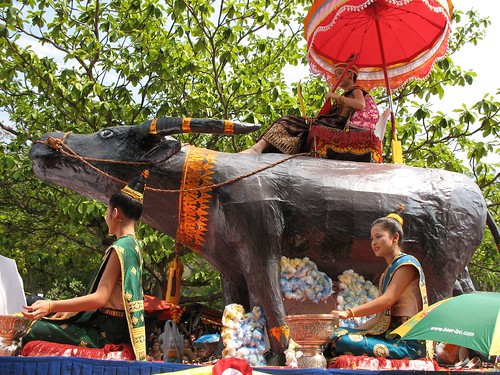
“In our province most people like to travel and enjoy time with families and friends during the day, while spending the cooler evenings at the temples taking part in rituals showing respect to Buddha images,” says Deputy Head of the Ministry of Information and Culture in Luang Prabang, Bounkhong Khutthoa.
Villagers here chose to visit temples in the evening because in the day they are busy, either travelling or working on their farms.
“Night-time activities are a delightful way for both locals and foreign visitors to celebrate the New Year. It is quite common to see people dressed up in their best attire to cleanse Buddha images in the traditional way. Now a lot of foreign visitors are joining in this longstanding practice,” Mr Bounkhong says.
When the sun goes down, young and old people alike begin heading to temples with the perfumed water they have prepared to sprinkle on the images in their local temples.
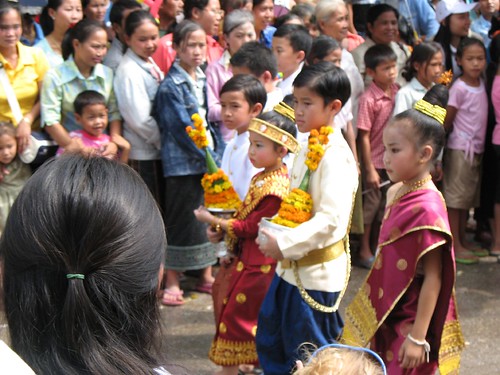
The highlight of this activity is the traditional style of clothing that everyone wears. The use of customary clothing, including a sash, adds to the devout atmosphere and demonstrates a respect for Lao culture.
This practice has been adhered to by people from generation to generation, as they believe that wearing wet clothes after a day of being soaked with water during other celebrations is inappropriate.
Although ceremonies differ slightly between provinces, the water used for temple rituals is similar across the country. It contains seasonal flowers and herbs such as dok champa (frangipani) and dokkhoun (a yellow tree blossom believed to be auspicious) . These trees are now in bloom all around the country. Sompoi , a fruit frequently used in cooking, khamin (turmeric) and perfumes are also added.
The water is stored in silver bowls. To show respect, shoes are not allowed nearby the altar where the images are placed for washing.
Small silver bowls are used to collect the water after it has being poured over the Buddha images. This is then trickled over the forehead of devotees, as the head is considered to be the holiest part of the body.
The remaining water is sprinkled around family homes to protect against evil spirits and bring good luck in the year to come.
Devotees perform this ritual in as many as nine to eleven temples, as it is believed to foster patience, perseverance, and success. It is recommended that people visit nine temples, as the number nine is considered to be lucky. Each temple devotee should visit a monk to be blessed and to have a white cotton string tied on their wrist.
Apart from this ritual, cultural and Buddhist ceremonies such as the building of sand stupas, singing traditional folk songs and candlelight processions are held in every temple.
Various traditional rituals are a drawcard for visitors from all over the world. Visitors will have a chance to experience the many traditional rites and customs that Luang Prabang has to offer over the New Year period.
Temples throughout Laos will perform Buddhist ceremonies, bringing out Buddha images to be washed by the faithful so they can purify themselves.
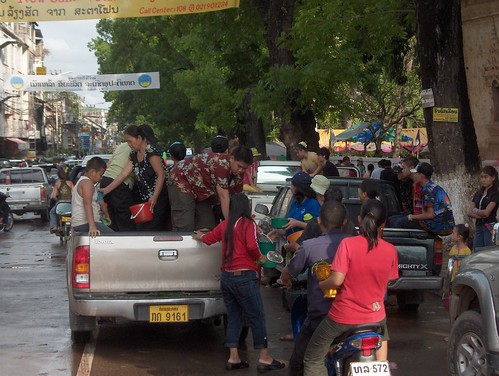
This year Sang khan luang (the first day of the Pi Mai Lao festival) falls on April 13. Homes, temples and public places are cleaned on this day. People also clean their bodies and think positively about the upcoming year.
Meu nau (the second day of the festival), sees the preparation of food and sweets to be offered to deceased relatives. It is thought that happiness and celebrations on this day will bring contentment throughout the year to come. It is believed that people should not sleep during this day.
The last day of the festival, Sa ng khan kheun , is the first day of the New Year when offerings are made to monks. Buddha images are washed and elders are sprinkled with water. On this day, visitors to Luang Prabang should take note to observe the columns and entrance ways to houses that people decorate with seasonal flowers, especially dokkhoun, as they believe it will bring good luck, prosperity and happiness.
By Phonesavanh Sangsomboun
Vientianetimes

The cool weather arriving after sunset in the World Heritage Town of Luang Prabang during Pi Mai Lao (Lao New Year) every year inspires people to put on their best clothes and visit local temples to sprinkle water on Buddha images.
Dressing in traditional clothes and washing Buddha images in the evening has long been a local custom. People believe visiting temples in wet clothes is inappropriate.
Celebrations not only take place in the city, but also in the surrounding suburbs, where traditional cultural activities occur.
Apart from numerous tourist attractions drawing visitors to the province, fascinating spectacles such as the Nangsangkhan (Miss Pi Mai) procession and the watering of Buddha images are a chance for visitors to observe local culture.
The watering of Buddha images during Pi Mai Lao is significant for Lao people, because this action is believed to wash away bad events from the past and bring luck and peace to families.

“In our province most people like to travel and enjoy time with families and friends during the day, while spending the cooler evenings at the temples taking part in rituals showing respect to Buddha images,” says Deputy Head of the Ministry of Information and Culture in Luang Prabang, Bounkhong Khutthoa.
Villagers here chose to visit temples in the evening because in the day they are busy, either travelling or working on their farms.
“Night-time activities are a delightful way for both locals and foreign visitors to celebrate the New Year. It is quite common to see people dressed up in their best attire to cleanse Buddha images in the traditional way. Now a lot of foreign visitors are joining in this longstanding practice,” Mr Bounkhong says.
When the sun goes down, young and old people alike begin heading to temples with the perfumed water they have prepared to sprinkle on the images in their local temples.

The highlight of this activity is the traditional style of clothing that everyone wears. The use of customary clothing, including a sash, adds to the devout atmosphere and demonstrates a respect for Lao culture.
This practice has been adhered to by people from generation to generation, as they believe that wearing wet clothes after a day of being soaked with water during other celebrations is inappropriate.
Although ceremonies differ slightly between provinces, the water used for temple rituals is similar across the country. It contains seasonal flowers and herbs such as dok champa (frangipani) and dokkhoun (a yellow tree blossom believed to be auspicious) . These trees are now in bloom all around the country. Sompoi , a fruit frequently used in cooking, khamin (turmeric) and perfumes are also added.
The water is stored in silver bowls. To show respect, shoes are not allowed nearby the altar where the images are placed for washing.
Small silver bowls are used to collect the water after it has being poured over the Buddha images. This is then trickled over the forehead of devotees, as the head is considered to be the holiest part of the body.
The remaining water is sprinkled around family homes to protect against evil spirits and bring good luck in the year to come.
Devotees perform this ritual in as many as nine to eleven temples, as it is believed to foster patience, perseverance, and success. It is recommended that people visit nine temples, as the number nine is considered to be lucky. Each temple devotee should visit a monk to be blessed and to have a white cotton string tied on their wrist.
Apart from this ritual, cultural and Buddhist ceremonies such as the building of sand stupas, singing traditional folk songs and candlelight processions are held in every temple.
Various traditional rituals are a drawcard for visitors from all over the world. Visitors will have a chance to experience the many traditional rites and customs that Luang Prabang has to offer over the New Year period.
Temples throughout Laos will perform Buddhist ceremonies, bringing out Buddha images to be washed by the faithful so they can purify themselves.

This year Sang khan luang (the first day of the Pi Mai Lao festival) falls on April 13. Homes, temples and public places are cleaned on this day. People also clean their bodies and think positively about the upcoming year.
Meu nau (the second day of the festival), sees the preparation of food and sweets to be offered to deceased relatives. It is thought that happiness and celebrations on this day will bring contentment throughout the year to come. It is believed that people should not sleep during this day.
The last day of the festival, Sa ng khan kheun , is the first day of the New Year when offerings are made to monks. Buddha images are washed and elders are sprinkled with water. On this day, visitors to Luang Prabang should take note to observe the columns and entrance ways to houses that people decorate with seasonal flowers, especially dokkhoun, as they believe it will bring good luck, prosperity and happiness.
By Phonesavanh Sangsomboun
Vientianetimes
Highlight of Lao New Year Festival
Vientiane residents to enjoy Lao New Year on islands
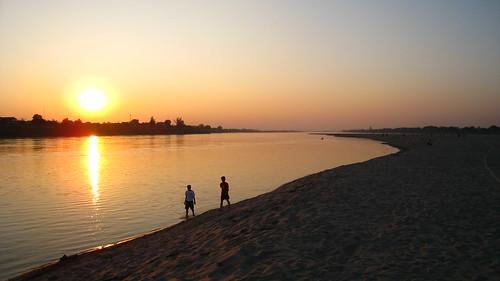
Photo: Sunset at Don Chan
Don Chan and Nongda islands will be two main areas of Vientiane where residents can enjoy Lao New Year celebrations, according to Vientiane Police Headquarters Chief Colonel Sihoun Sithiluexay.
Colonel Sihoun said sport, water games and entertainment would be provided at the two sites during the traditional water festival.
“Today, Don Chan island is opening for sporting activities,” he said.
“We hope all Vientiane residents and foreign visitors will enjoy our traditional festival from April 13 to 15. Meanwhile, we also hope they will play safely and in a socially acceptable way by following our regulations and suggestions.”
He said his police would work with soldiers and local authorities in the three districts of Chanthabouly, Sikhottabong and Sisattanak in order to follow the regulations.
“Officials and local authorities are not the only ones who need to work during Pi Mai Lao, local people also have to be alert to security by keeping their eyes open for theft, fire or accidents,” he stressed.
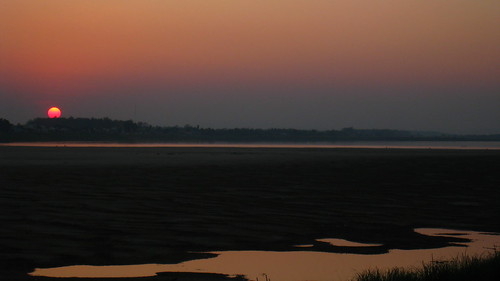
Colonel Sihoun said the other districts in Vientiane would have their own taskforces to address security and to allow local people to enjoy the traditional customs of Laos at their local places of ce lebration.
Colonel Sihoun said his taskforce would encourage all staff to work hard to educate the public about following the Pi Mai Lao regulations issued by the Vientiane Administration Office.
The regulations ban carrying tanks of water on vehicles, throwing coloured or dirty water and plastic bags filled with water, and pouring water over motorbike riders, he added
“We mostly worry about road accidents because they increase considerably during the three days of celebration, compared to a normal week,” he said.
“There are usually about 50 accidents reported each week, but this same number usually occurs during the three days of the festival.”
Because accidents are a major problem every Pi Mai Lao, traffic police will be extra vigilant about stopping drunk drivers and preventing motorbike racing.
Last year the Vientiane traffic police reported 45 road accidents during the festival, including two fatalities.
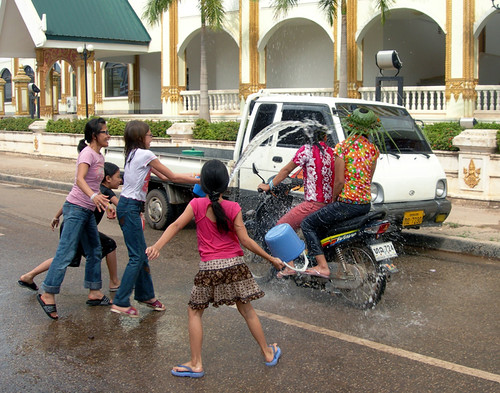
From January to March this year there have already been almost 600 road accidents in Vientiane , claiming the lives of 20 people, Vientiane Traffic Police and Fire Fighting Division Chief Lieutenant Colonel Khamphew Vatthanaphone said earlier this month.
By Panyasith Thammavongsa
Source: vientianetimes

Photo: Sunset at Don Chan
Don Chan and Nongda islands will be two main areas of Vientiane where residents can enjoy Lao New Year celebrations, according to Vientiane Police Headquarters Chief Colonel Sihoun Sithiluexay.
Colonel Sihoun said sport, water games and entertainment would be provided at the two sites during the traditional water festival.
“Today, Don Chan island is opening for sporting activities,” he said.
“We hope all Vientiane residents and foreign visitors will enjoy our traditional festival from April 13 to 15. Meanwhile, we also hope they will play safely and in a socially acceptable way by following our regulations and suggestions.”
He said his police would work with soldiers and local authorities in the three districts of Chanthabouly, Sikhottabong and Sisattanak in order to follow the regulations.
“Officials and local authorities are not the only ones who need to work during Pi Mai Lao, local people also have to be alert to security by keeping their eyes open for theft, fire or accidents,” he stressed.

Colonel Sihoun said the other districts in Vientiane would have their own taskforces to address security and to allow local people to enjoy the traditional customs of Laos at their local places of ce lebration.
Colonel Sihoun said his taskforce would encourage all staff to work hard to educate the public about following the Pi Mai Lao regulations issued by the Vientiane Administration Office.
The regulations ban carrying tanks of water on vehicles, throwing coloured or dirty water and plastic bags filled with water, and pouring water over motorbike riders, he added
“We mostly worry about road accidents because they increase considerably during the three days of celebration, compared to a normal week,” he said.
“There are usually about 50 accidents reported each week, but this same number usually occurs during the three days of the festival.”
Because accidents are a major problem every Pi Mai Lao, traffic police will be extra vigilant about stopping drunk drivers and preventing motorbike racing.
Last year the Vientiane traffic police reported 45 road accidents during the festival, including two fatalities.

From January to March this year there have already been almost 600 road accidents in Vientiane , claiming the lives of 20 people, Vientiane Traffic Police and Fire Fighting Division Chief Lieutenant Colonel Khamphew Vatthanaphone said earlier this month.
By Panyasith Thammavongsa
Source: vientianetimes
Where to enjoy Lao New Year in Vientiane ? Find out here
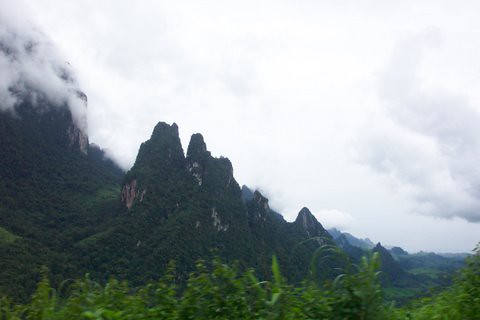
The Asian Development Bank (ADB) has agreed to a grant of around 100 billion kip (US$10 million) to the Lao for developing sustainable tourism in eight provinces of Laos between 2009 and 2013.
The assistance will go to Siphandone tourism development project in Champassak province, wastewater treatment system construction and improvement project in Vangvieng district, Vientiane province, and the tourism development activities along the north-south economic corridor project (Luang Namtha and Bokeo, northern Laos)
The grant will also help develop community–based ecotourism in Bokeo, Sayaboury, Oudomsay, Houaphanh, Saravane and Vientiane provinces. In addition, the funds will be used to develop human resources in the tourism sector.
The Vice Chairman of the Lao National Tourism Administration, Mr Vang Rattanavong, signed a Memorandum of Understanding (MoU) on Feb 15, in Vientiane with the bank’s Mission Leader, Mr Alfredo Perdiguero.
In the past, ADB has provided loans for Laos in the Mekong Tourism Development Project worth US$10.5 million. The Bank off ered the grant to Laos after successfully completing the fi rst phase of Mekong Tourism Development Project, according to an LNTA press release.
Source: Mlao
ADB Grant US$ 10 Million for sustainable to tourism in Laos
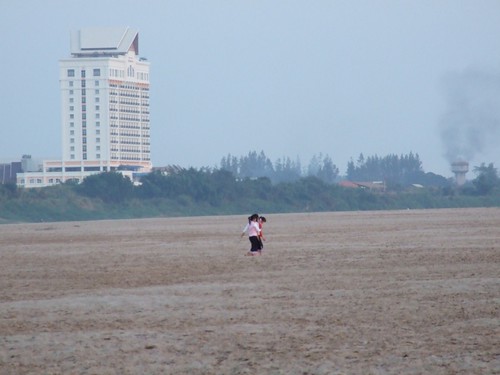
The Ten hotels from Laos are among 81 hotels from Asean countries honoured with the Asean Green Hotel Award. There are
1. Donchan Palace Hotel
2. Lao Plaza Hotel
3. Novotel Hotel
4. Settha Palace Hotel
5. Taipan Hotel
6. Green Park Boutique Hotel
7. Phouvao Hotel
8. Souvannaphoum Hotel
9. The Grand Hotel
10.Champasak Palace Hotel.
Cambodia, Indonesia, Myanmar, Singapore, Thailand and Vietnam have 10 hotels each in the category, the Philippines and Malaysia each in five and Brunei one.
The Asean Green Hotel Award to the 81 selected hotels were presented at the Asean Tourism Ministers’ meeting on January 22 in Bangkok by Asean secretary-general Dr. Surin Pitsuwan, which was also attended by Laos's Tourism Minister Somphong Mongkhonvilay.
The ward for hotels is only fi rst step, Asean look now to award restaurants and souvenir shops, Green Award Recognition is also of great virtue for travelers.
Source: Mlao
Ten hotels from Laos won ASEAN Green Hotel Award
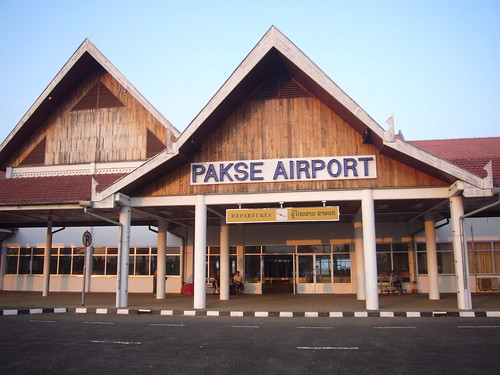
(KPL) The authority of Champassak province is now working hard to construct, improve and extend the Pakse airport as the International airport. The 233,333,000 Thai bath renovation project is expected to be completed by October, 2009.
According to the source from the Public Work and Transport Department, Champassak province, the renovation project has started to survey for renovation since 2005 but the survey has temporary stopped due to the financial problem. The renovation activities for the airport has been started again from March 2008 by Thai Italian construction company.
The project worth 233,333,000 bath is 70% of loan from Thai government, and 30% of grant aid from Thai government too. The renovation works includes 2,400 m runway, which able to receive aircraft of Boing 737-400, forker 70, and airbus A 320 flying from Pakse to Hanoi, BangKok, Phnom Penh, Kunming and Hongkong.
In addition, the construction work will cover the construction of air control station, parking areas for aircraft and other facilities.
After completion, the airport will accommodate 95,400 passergers a year.
Source: kpl
Pakse airport to be upgraded to international standard
Đăng ký:
Nhận xét
(
Atom
)



.jpg)
